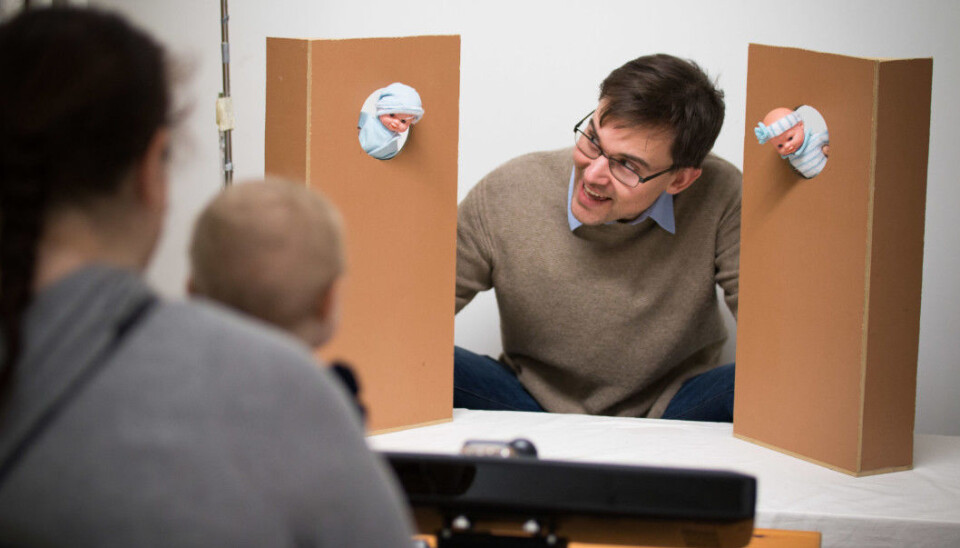
Babies can show signs of autism early in life
Babies who were just 10 months old and who later received a diagnosis of Autism Spectrum Disorder took less initiative than other children to communicate with adults.
Researchers have known that Autism Spectrum Disorder (ASD) can be detected in children as young as age two. Now, Swedish researchers have found signs of autism in even younger children who were subsequently diagnosed with the condition.
Using eye movement measurements, the researchers tested the response pattern of infants exposed to visual stimuli. They then checked in on the children at age 3 to see if any had received a diagnosis of ASD.
The results suggest that children with ASD have less social motivation as infants, according to researchers at Uppsala University, who conducted the study.
The study has been published in the journal Biological Psychiatry.
Sharing experiences

Both infants and parents normally use their voice or other signs to share experiences.
Little children can get the attention of an adult by making noise, which allows them to meet their needs and interests. This is an important way that infants learn language and social skills.
Before they can talk or point, however, babies use their eyes to influence their parents. They might look back and forth between their parents and a cat, balloon or bird they think is exciting, for example.
Siblings of children with autism
This early, silent communication was precisely what the researchers wanted to investigate.
They wanted to see if they would find differences in 10-month-old babies by measuring their eye movements and factoring in their risk of autism.
The study included children who had an older sibling with autism. Most younger siblings of children who have been diagnosed with ASD develop normally. But they nevertheless have a higher probability of being diagnosed with ASD than the general population.
The researchers used children who were not at increased risk of ASD as a control group. A total of 112 infants participated in surveys that were characterized by play, while an eye tracker recorded their gaze.
“The results indicate that children with autism do not take as much initiative to communicate with adults as normal when they are infants,” says researcher Terje Falck-Ytter at the Department of Psychology at Uppsala University.
A flashing light
The children sat on their parents' knees when an unusual and brightly coloured lamp suddenly began to flash. The lamp flashed for 10 seconds so that the child had time to initiate communication with the researcher, who sat next to the lamp but with a wall between the researcher and the lamp.
From the baby's point of view, it looked as if the researcher could not see the lamp.
Where and how often the children shifted their gaze was measured using eye-tracking technology. This counts the number of times the baby shifted its gaze and measured where the infant’s gaze was directed.
All the children followed the researcher's gaze, regardless of whether they later received a diagnosis of ASD or not.
But there was a difference between how eager the children were to try to call the researcher’s attention to the lights, to "say" some about what they saw.
Less likely to seek contact
Most infants looked back and forth between the flashing light and the researcher a number of times, as if they were trying to share the experience with the adult.
Infants who were later diagnosed with ASD also spontaneously followed the adult's initiative with their gaze, like other infants.
But these kids rarely took the initiative to share their own experiences with the adult. They rarely looked back and forth between the lamp and the adult.
These children were at higher risk of having an ASD diagnosis later.
The researchers believe this supports the hypothesis that children with autism already show signs of reduced social motivation when they are infants.
Differences and exceptions
“We assume that the results may have relevance for social interaction outside the laboratory situation as well,” Terje Falck-Ytter wrote in an email.
The differences were vague and can be difficult to see with the naked eye. But it’s quite possible to detect them using modern eye tracking equipment.
The researchers found clear statistical differences between the children who were healthy and those who were later diagnosed with ASD. But the accuracy was too low to predict what would happen with each individual child.
And there were exceptions in both groups.
Too early to determine clinical value
Falck-Ytter said it’s too early to say if these kinds of measurements can be developed into a method for early detection of autism.
The children in the study were 10, 14 and 18 months old when the eye-tracking studies were done. The autism investigation was done when they were three.
A total of 81 younger siblings of children with ASD were included in the study. Of these, 22 children met the criteria for autism in the follow-up, which is just over one in four children.
The control group consisted of 31 children who had older siblings who had not been diagnosed with ASD.
----------------------------







